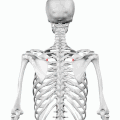| Spine of scapula | |
|---|---|
 Left scapula seen from behind (spine of scapula shown in red) | |
 Position of spine of scapula shown in red | |
| Details | |
| Identifiers | |
| Latin | spina scapulae |
| TA98 | A02.4.01.005 |
| TA2 | 1147 |
| FMA | 13453 |
| Anatomical terms of bone | |
The spine of the scapula or scapular spine is a prominent plate of bone, which crosses obliquely the medial four-fifths of the scapula at its upper part, and separates the supra- from the infraspinatous fossa.














